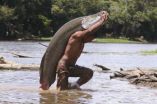(Press-News.org) SAN FRANCISCO, Aug. 13, 2014 — Dusty air blowing across the Pacific from Asia and Africa plays a critical role in precipitation patterns throughout the drought-stricken western U.S. Today, a scientist will present new research suggesting that the exact chemical make-up of that dust, including microbes found in it, is the key to how much rain and snow falls from clouds throughout the region. This information could help better predict rain events, as well as explain how air pollution from a variety of sources influences regional climate in general.
She will present a talk on how aerosols impact clouds and climate at the 248th National Meeting & Exposition of the American Chemical Society (ACS), the world's largest scientific society. The meeting is taking place here through Thursday and features nearly 12,000 scientific presentations.
"We've learned that not all of the particles in the air at high altitudes have the same influence on clouds. We're starting to think that these differences contribute to how rain gets distributed," says Kim Prather, Ph.D.
Most of the dust that Prather's team at the University of California, San Diego, detects in clouds and precipitation originates in Asian and Chinese deserts. It gets swept westward by the jet stream where it mixes with a variety of other airborne particles such as sea spray and smoke. Prather says that each of these types of particles — collectively known as aerosols — has its own, distinctive impact on clouds.
A major key to what turns ordinary clouds into rainmakers in the first place is their ability to form ice crystals around the microscopic particles that invade and "seed" them, Prather said. Without ice crystals as a catalyst, rain development inside clouds can be impaired.
"The standard belief is the more ice you have in a cloud, the more likely you will get precipitation out of it," she says. "Our goal is to catch the first stages of ice forming and find out what exactly the chemical constituents are that the ice is forming on."
Prather and her team use special single-particle mass spectrometers, which sample cloud droplets and ice crystals in real-time. The instruments are used aboard research aircraft flying through clouds high above the western seaboard. One of her most recent — and surprising — discoveries is that the material she measures is remarkably loaded with signs of life.
"We're seeing lots of biological components such as bacteria and molecules associated with microbial life," she says. "In fact, many of the species we find in the ice crystals have these biological chemicals and are not simply dust particles."
Prather speculates that the microbes hitch a ride on bits of sand, iron and other debris swept aloft from desert regions. Microbes and biological components could also become mixed with the dust as it is transported across the Pacific. She and her team are eager to learn just how important these bioparticles are in the rainmaking process.
Such research eventually could lead to more accurate weather forecasting and rainfall predictions, she believes. Only recently have some computer weather models begun to use dust data gathered by satellite imagery that captures dust's sweep toward the west coast.
"Long term, our goal is to be able to predict how much precipitation we can expect to form when certain aerosols such as dust are coming toward us," says Prather. "That's a lofty goal but we're making headway."
Another pay-off to her research also could be a way to improve cloud-seeding technology. Since the late 1940s, cloud seeding in certain parts of the continental U.S. has been commonplace, even though results continue to be spotty. Prather says her current research may help identify better ways of seeding clouds based on the natural processes she studies. "It's clear that Mother Nature has developed very effective ways to seed clouds, so perhaps we could take some tips from her."
INFORMATION:
A press conference on this topic will be held Wednesday, August 13, at 2 p.m. Pacific time in the Moscone Center, North Building. Reporters may report to Room 113 in person, or access live video of the event and ask questions at the ACS Ustream channel ACS Ustream channel.
Prather acknowledges funding from the Centers for Chemical Innovation program at the National Science Foundation and the California Energy Commission.
The American Chemical Society is a nonprofit organization chartered by the U.S. Congress. With more than 161,000 members, ACS is the world's largest scientific society and a global leader in providing access to chemistry-related research through its multiple databases, peer-reviewed journals and scientific conferences. Its main offices are in Washington, D.C., and Columbus, Ohio.
To automatically receive news releases from the American Chemical Society, contact newsroom@acs.org.
Note to journalists: Please report that this research is being presented at a meeting of the American Chemical Society.
Follow us: Twitter | Facebook
Title
Impact of aerosols on clouds and regional climate
Abstract
Atmospheric aerosols are produced by a variety of sources including emissions from cars and trucks, wildfires, ships, dust, and sea spray and play a significant role in impacting air pollution and regional climate. Aerosols can warm or cool our planet depending on the composition of individual particles. Particle composition controls reactivity, water uptake, and ice nucleation and thus different sources will have different impacts on climate. As a result of their chemical complexity, climate models often ignore the composition of aerosols, thus limiting our ability to predict future climate. Given the complexity of the atmosphere, one of the greatest challenges scientists face involves unraveling the impacts of natural versus anthropogenic sources on our atmosphere and climate. This presentation will describe recent field and lab studies focused on using on-line single particle mass spectrometry to untangle the impacts of local and long range transported pollution, dust, and sea spray particles on cloud properties and regional climate. Details will be presented on how complementary studies of atmospheric aerosols and meteorology can be used to determine how aerosols from as far away as Africa can change the precipitation in the western United States.
Dust -- and the microbes hitching rides on it -- influences rain, climate
2014-08-13
ELSE PRESS RELEASES FROM THIS DATE:
Rooting out skin creams that contain toxic mercury
2014-08-13
SAN FRANCISCO, Aug. 13, 2014 — As countries try to rid themselves of toxic mercury pollution, some people are slathering and even injecting creams containing the metal onto or under their skin to lighten it, putting themselves and others at risk for serious health problems. To find those most at risk, scientists are reporting today that they can now identify these creams and intervene much faster than before. They're speaking at the 248th National Meeting & Exposition of the American Chemical Society (ACS).
The meeting, organized by the world's largest scientific society, ...
Tattoo biobatteries produce power from sweat (video)
2014-08-13
SAN FRANCISCO, Aug. 13, 2014 — In the future, working up a sweat by exercising may not only be good for your health, but it could also power your small electronic devices. Researchers will report today that they have designed a sensor in the form of a temporary tattoo that can both monitor a person's progress during exercise and produce power from their perspiration.
The team described the approach in one of nearly 12,000 presentations at the 248th National Meeting & Exposition of the American Chemical Society (ACS), the world's largest scientific society, taking place ...
A new look at what's in 'fracking' fluids raises red flags
2014-08-13
SAN FRANCISCO, Aug. 13, 2014 — As the oil and gas drilling technique called hydraulic fracturing (or "fracking") proliferates, a new study on the contents of the fluids involved in the process raises concerns about several ingredients. The scientists presenting the work today at the 248th National Meeting & Exposition of the American Chemical Society (ACS) say that out of nearly 200 commonly used compounds, there's very little known about the potential health risks of about one-third, and eight are toxic to mammals.
The meeting features nearly 12,000 presentations on ...
Passengers who survived terrifying Air Transat flight in 2001 help psychologists uncover new clues about post-traumatic stress vulnerability
2014-08-13
Toronto, Canada – An extraordinary opportunity to study memory and post-traumatic stress disorder (PTSD) in a group of Air Transat passengers who experienced 30 minutes of unimaginable terror over the Atlantic Ocean in 2001 has resulted in the discovery of a potential risk factor that may help predict who is most vulnerable to PTSD.
The study, led by researchers at Baycrest Health Sciences, is published online this week in the journal Clinical Psychological Science – ahead of print publication. It is the first to involve detailed interviews and psychological testing in ...
Why seniors don't eat: It's complicated
2014-08-13
WASHINGTON – More than half of older adults who visit emergency departments are either malnourished or at risk for malnutrition, but not because of lack of access to health care, critical illness or dementia. Despite clear signs of malnutrition or risk of malnutrition, more than three-quarters had never previously been diagnosed with malnutrition, according to the results of a study to be published online tomorrow in Annals of Emergency Medicine ("Malnutrition Among Cognitively Intact, Non-Critically Ill Older Adults in the Emergency Department").
"We were surprised ...
Giant Amazon fish becoming extinct in many fishing communities, saved in others
2014-08-13
An international team of scientists has discovered that a large, commercially important fish from the Amazon Basin has become extinct in some local fishing communities.
The team compared mainstream bioeconomic theory — which policymakers have depended on in order to protect fish populations — with the lesser-known "fishing-down" theory, which predicts that large, high-value, easy-to-catch fish can be fished to extinction.
"Bioeconomic thinking has predicted that scarcity would drive up fishing costs, which would increase price and help save depleted species," said study ...
Gene that controls nerve conduction velocity linked to multiple sclerosis
2014-08-13
Philadelphia, PA, August 13, 2014 – A new study published in The American Journal of Pathology identifies a novel gene that controls nerve conduction velocity. Investigators report that even minor reductions in conduction velocity may aggravate disease in multiple sclerosis (MS) patients and in mice bred for the MS-like condition experimental autoimmune encephalomyelitis (EAE).
A strong tool for investigating the pathophysiology of a complex disease is the identification of underlying genetic controls. Multiple genes have been implicated as contributing to the risk of ...
Clotting drug linked to fewer blood transfusions in joint surgery
2014-08-13
Tranexamic acid has been shown to reduce blood loss during or shortly after major joint surgery (the perioperative stage). However, safety concerns remain because large scale effectiveness studies are lacking.
In the USA, over 1 million hip and knee replacements are performed each year. In
England and Wales the figure is about 180,000.
So a team of US researchers, led by Dr Stavros Memtsoudis at Hospital for Special Surgery, Weill Cornell Medical College, and Dr Jashvant Poeran at Mount Sinai School of Medicine, both in New York, set out to determine the effectiveness ...
The Lancet Diabetes & Endocrinology: 2 out of every 5 Americans expected to develop type 2 diabetes during their lifetime
2014-08-13
Close to half (40%) of the adult population of the USA is expected to develop type 2 diabetes at some point during their lifetime, suggests a major study published in The Lancet Diabetes & Endocrinology. The future looks even worse for some ethnic minority groups, with one in two (> 50%) Hispanic men and women and non-Hispanic black women predicted to develop the disease.
A team of US researchers combined data from nationally representative US population interviews and death certificates for about 600 000 adults to estimate trends in the lifetime risk of diabetes and ...
The Lancet: nearly half of women at risk of preterm birth do not receive cheap drug that could prevent millions of newborn deaths
2014-08-13
A major international study of more than 303 000 births in 29 low-income and middle-income countries has found that only half (52%) of women who are eligible to receive a simple, effective, low-cost treatment to prevent death and disability in their newborn babies are getting it.
The findings, published in The Lancet, highlight striking gaps in the practice of using antenatal (before birth) steroid injections—known to significantly reduce the risk of death, respiratory distress syndrome (a consequence of immature lung development), cerebroventricular haemorrhage (bleeding ...


